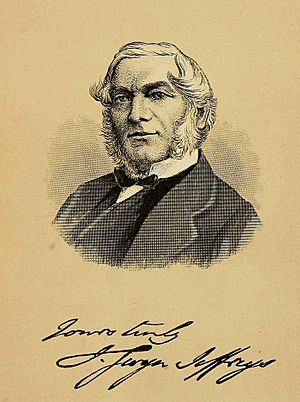John Gwyn Jeffreys facts for kids
Quick facts for kids
John Gwyn Jeffreys
|
|
|---|---|
 |
|
| Born | 18 January 1809 Swansea, Wales
|
| Died | 21 January 1885 (aged 76) |
| Nationality | British |
| Scientific career | |
| Fields | conchology, malacology |
| Signature | |
John Gwyn Jeffreys (born January 18, 1809 – died January 21, 1885) was a British scientist who studied shells and the animals that live inside them. He was known as a conchologist (someone who studies shells) and a malacologist (someone who studies molluscs, which are soft-bodied animals like snails and clams).
Contents
Early Life and Education
John Gwyn Jeffreys was born in Swansea, Wales, on January 18, 1809. He went to school in Swansea at the Bishop Gore School. When he was 17, he started training to become a lawyer. Later, he moved to London and became a barrister (a type of lawyer) in 1838.
A Passion for Shells
John worked as a lawyer in Swansea for many years. But his real passion was studying shells and the creatures that make them. He didn't just want to collect shells; he wanted to understand everything about how molluscs lived.
On April 2, 1840, he became a member of the important Royal Society, which is a group for top scientists. A few months later, on June 21, he married Ann Nevill. They had five children together. One of their grandchildren was the famous physicist, Henry Gwyn Jeffreys Moseley.
Deep-Sea Explorations
In 1866, John Jeffreys retired from his law career. This allowed him to spend more time on his true passion: exploring the ocean. He had already started some deep-sea explorations in 1861 using a yacht called Osprey. He later bought this yacht himself.
He often went on these trips with other marine life experts. They used a method called dredging, which involves dragging a net along the seabed to collect samples. They explored the seas around the Shetland Islands, western Scotland, the English Channel, and the Irish Sea. He also traveled to Norway for expeditions.
John Jeffreys became a leader on several important deep-sea expeditions. These included the Porcupine expeditions in 1869 and 1870, the Valorous expedition to Greenland in 1875, and the French Travailleur expedition in 1880. These trips helped scientists learn a lot about marine life in deep waters.
Later Life and Legacy
Around 1866, John Jeffreys moved from London to Ware in Hertfordshire. He bought a place called Greyfriars Priory, which became a popular meeting spot for artists from Britain and other countries. He also served as a Justice of the Peace in several areas and was appointed High Sheriff of Hertfordshire in 1877.
He was also a treasurer for many years at the Linnean Society of London and the Geological Society of London, which are important scientific groups. John Jeffreys was also a member of the British Science Association.
After his wife passed away in 1881, John Jeffreys moved to Kensington. He died there on January 24, 1885.
His most famous work was a five-volume book called 'British Conchology'. It was considered the best book on the subject at the time. He worked very hard throughout his life. Even just four days before he died, he was still describing new deep-sea molluscs that had been found during expeditions.
John Jeffreys was the first to scientifically describe many species of shells. Some examples include Rissoella opalina (in 1848), Cima minima (in 1858), and Cheirodonta pallescens (in 1867).
His large collection of shells and specimens was bought by William Healey Dall for the Smithsonian Institution in the United States. Parts of this collection were later given to the National Museum of Natural History in Washington, D.C.
Images for kids

